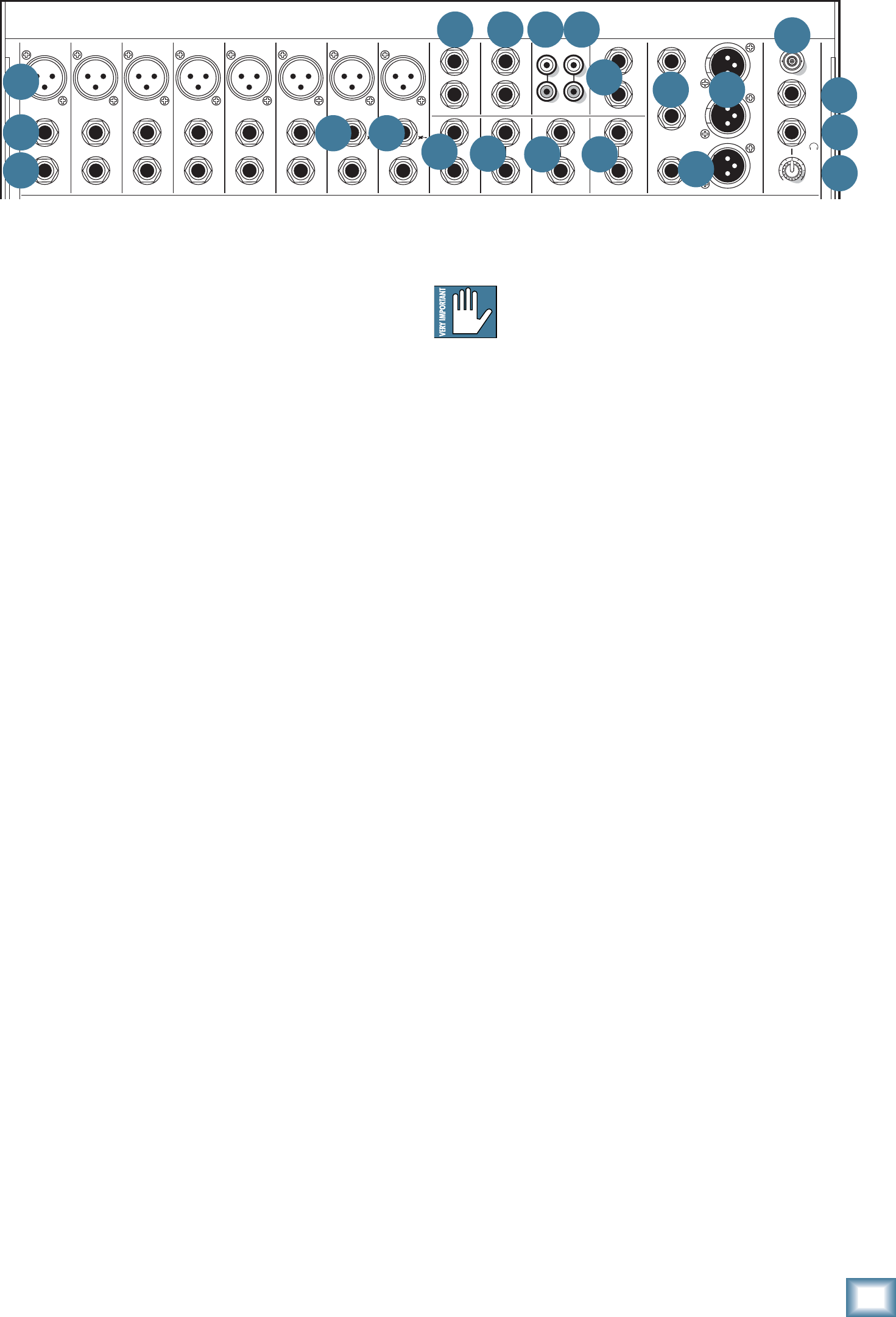
11
Owner’s Manual
Owner’s Manual
Never plug single-ended (unbalanced) micro-
phones, or ribbon mics into the mic input
jacks if phantom power is on. Do not plug
instrument outputs into the mic XLR input jacks with
phantom power on, unless you know for certain it is safe
to do so.
6. MONO LINE INPUTS (Ch. 1 to 6)
These 1/4" jacks share circuitry (but not phantom
power) with the mic preamps, and can be driven by bal-
anced or unbalanced sources.
To connect balanced lines to these inputs, use a 1⁄4"
Tip-Ring-Sleeve (TRS) plug.
To connect unbalanced lines to these inputs, use a
1⁄4" mono (TS) phone plug or instrument cable.
7. LINE/INSTRUMENT INPUTS (Ch. 7 and 8)
The line-level inputs for channels 7 and 8 can also
accept instrument-level signals if the hi-z switches
[26] are pressed in. This allows you to connect guitars
directly to channels 7 and 8, without the need for a DI
box. The input impedance is optimized for direct con-
nection, and high-frequency fi delity is assured.
8. STEREO LINE INPUTS (Ch. 9/10 and 11/12)
These channels have stereo line inputs. If you just
have a mono source, plug it into the left input channel
9 or 11 (labeled left/mono), and the signal will appear
(as if by magic) equally on the left and right of the main
mix.
Connection Section
This is where you plug in things such as: microphones,
line-level instruments, guitars, and effects, a recorder,
PA system, powered monitors, powered subwoofer etc.
(The speaker-level outputs from the internal power
amplifi ers are on the rear panel.) Check out the hookup
diagrams for some connection ideas. See Appendix B
(page 29) for further details and some rather lovely
drawings of the connectors you can use with your mixer.
5. MIC INPUTS
We use phantom-powered, balanced microphone
inputs just like the big studio mega-consoles, for exactly
the same reason: This kind of circuit is excellent at
rejecting hum and noise. You can plug in almost any
kind of mic that has a standard XLR-type male mic con-
nector.
Professional ribbon, dynamic, and condenser mics all
sound excellent through these inputs. The mic inputs
will handle any kind of mic level you can toss at them,
without overloading.
Microphone-level signals are passed through the
mixer's splendid microphone preamplifi ers to become
line-level signals.
Channels 1 to 6 have the extra benefi t of dedicated
in-line compressors [25]. These can be adjusted to add
just the right amount of compression to your vocals and
help prevent distortion and overloading.
PHANTOM POWER
Most modern professional condenser mics require
48V phantom power, which lets the mixer send low-cur-
rent DC voltage to the mic’s electronics through the
same wires that carry audio. (Semi-pro condenser mics
often have batteries to accomplish the same thing.)
“Phantom” owes its name to an ability to be “unseen”
by dynamic mics (Shure SM57/SM58, for instance),
which don’t need external power and aren’t affected by
it anyway.
The mixer's phantom power is globally controlled by
the phantom [43] switch. (The phantom power for all
channels is turned on and off together.)
MIC 1 MIC 2 MIC 3 MIC 4 MIC 5 MIC 6 MIC 7 MIC 8
INPUT
(BAL/UNBAL) (BAL/UNBAL) (BAL/UNBAL) (BAL/UNBAL) (BAL/UNBAL) (BAL/UNBAL) (BAL/UNBAL) (BAL/UNBAL)
INSERT INSERT INSERT INSERT INSERT INSERT INSERT INSERT
LAMP
12V 0.5A
L
R
FX SEND TA PE
OUTIN
L
MON SEND
FX RTN
(MONO)
1
2
L
R
(MONO)
L
R
(MONO)
L
R
(MONO)
1
2
FX RTN
L
R
L
R
M
L
R
M
9
12
10/
INPUT
11 12/
MAIN OUT
MAIN INSERT
FOOTSWITCH
TIP: FX1
RING: FX2
PHONES
FX
LEVEL
OO
MAX
LINELINELINELINELINELINELINE
HI-Z
LINE
HI-Z
1+
1
1+
1
R
14 13 11 10
11
6
7
8
8
12 12
15
16
17
16
7
5
21
20
18
19


















